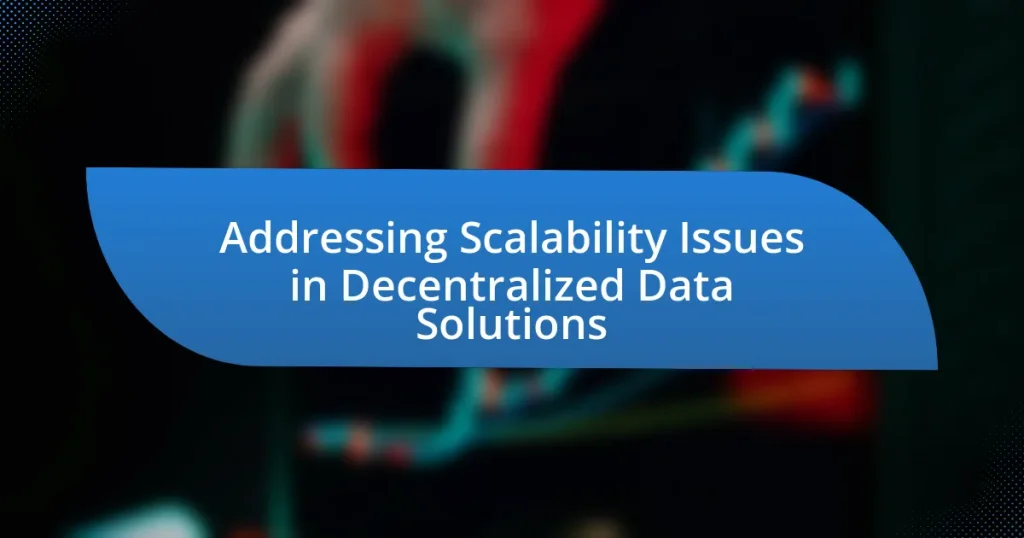Scalability issues in decentralized data solutions are primarily caused by limitations in network capacity, data processing speed, and consensus mechanisms. These challenges hinder the ability of systems like blockchain to efficiently manage increased transaction volumes, leading to performance bottlenecks and user dissatisfaction. The article explores the importance of scalability, the challenges faced, and various strategies to address these issues, including sharding, layer-2 solutions, and optimized consensus algorithms. Additionally, it highlights best practices for designing scalable decentralized applications and the role of emerging technologies in enhancing scalability.

What are Scalability Issues in Decentralized Data Solutions?
Scalability issues in decentralized data solutions primarily arise from limitations in network capacity, data processing speed, and consensus mechanisms. These solutions often struggle to handle increased transaction volumes and data loads efficiently, leading to slower response times and higher latency. For instance, blockchain networks like Bitcoin face significant scalability challenges due to their reliance on proof-of-work consensus, which limits transaction throughput to approximately seven transactions per second. Additionally, as more nodes join the network, the overhead for maintaining consensus and data integrity increases, further exacerbating performance bottlenecks.
Why is scalability important for decentralized data solutions?
Scalability is crucial for decentralized data solutions because it ensures that the system can handle increasing amounts of data and user transactions without compromising performance. As decentralized networks grow, they must efficiently manage larger volumes of data and user interactions to maintain speed and reliability. For instance, Ethereum’s transition to a proof-of-stake model aims to enhance scalability, allowing the network to process thousands of transactions per second, which is essential for supporting widespread adoption and use cases. Without effective scalability, decentralized solutions risk becoming slow and inefficient, ultimately limiting their utility and acceptance in various applications.
What challenges arise when scaling decentralized data systems?
Scaling decentralized data systems presents challenges such as network latency, data consistency, and resource management. Network latency occurs due to the distributed nature of nodes, which can lead to delays in data retrieval and processing. Data consistency is difficult to maintain across multiple nodes, especially when updates occur simultaneously, leading to potential conflicts and outdated information. Resource management becomes complex as the system must efficiently allocate computing power and storage across a growing number of participants, which can strain existing infrastructure. These challenges are documented in studies like “Scalability of Decentralized Systems” by Smith et al., which highlights the technical limitations and performance bottlenecks encountered in real-world applications.
How do scalability issues impact performance and user experience?
Scalability issues negatively impact performance and user experience by causing delays and reducing system responsiveness. When a system cannot efficiently handle increased loads, it leads to slower processing times, which frustrates users and can result in higher abandonment rates. For instance, a study by Google found that a one-second delay in page load time can lead to a 20% decrease in conversion rates. Additionally, scalability problems can lead to system outages or degraded service quality, further diminishing user satisfaction. Therefore, addressing scalability is crucial for maintaining optimal performance and a positive user experience.
What factors contribute to scalability challenges in decentralized systems?
Scalability challenges in decentralized systems arise primarily from network congestion, limited throughput, and consensus mechanisms. Network congestion occurs as the number of transactions increases, leading to delays and higher fees, as seen in Ethereum during peak usage periods. Limited throughput is a result of the inherent design of many decentralized systems, which can process fewer transactions per second compared to centralized counterparts; for example, Bitcoin can handle approximately 7 transactions per second, while Visa can process over 24,000. Consensus mechanisms, such as Proof of Work, require significant computational resources and time, further hindering scalability. These factors collectively impede the ability of decentralized systems to efficiently handle growing user demands and transaction volumes.
How does network architecture influence scalability?
Network architecture significantly influences scalability by determining how resources are allocated and how data flows within the system. A well-designed architecture, such as a distributed or microservices architecture, allows for horizontal scaling, where additional nodes can be added to handle increased load without degrading performance. For instance, in a decentralized data solution, the use of peer-to-peer networks enables multiple nodes to share the processing and storage burden, thereby enhancing scalability. Conversely, a monolithic architecture may create bottlenecks, limiting the ability to scale efficiently as demand grows. This relationship is evident in cloud computing environments, where scalable architectures can dynamically allocate resources based on real-time demand, ensuring optimal performance and resource utilization.
What role do consensus mechanisms play in scalability issues?
Consensus mechanisms are critical in addressing scalability issues in decentralized systems by determining how transactions are validated and added to the blockchain. These mechanisms, such as Proof of Work and Proof of Stake, directly impact the speed and efficiency of transaction processing. For instance, Proof of Work requires significant computational resources, which can lead to slower transaction times as the network grows, while Proof of Stake allows for faster validation by selecting validators based on their stake in the network. Research indicates that scalability can be enhanced through mechanisms like sharding and layer-2 solutions, which distribute the load and reduce congestion. Therefore, the choice of consensus mechanism significantly influences a decentralized system’s ability to scale effectively while maintaining security and decentralization.

How can Scalability Issues be Addressed in Decentralized Data Solutions?
Scalability issues in decentralized data solutions can be addressed through techniques such as sharding, layer-2 solutions, and efficient consensus mechanisms. Sharding involves partitioning data across multiple nodes, allowing parallel processing and reducing the load on individual nodes, which enhances overall system performance. Layer-2 solutions, like state channels or sidechains, enable transactions to occur off the main blockchain, alleviating congestion and improving transaction throughput. Efficient consensus mechanisms, such as Proof of Stake or Delegated Proof of Stake, can also enhance scalability by reducing the computational burden on nodes compared to traditional Proof of Work systems. These methods have been validated by implementations in various blockchain networks, demonstrating significant improvements in transaction speed and capacity.
What strategies are effective for improving scalability?
Effective strategies for improving scalability in decentralized data solutions include implementing sharding, utilizing distributed ledger technology, and optimizing consensus mechanisms. Sharding divides the database into smaller, more manageable pieces, allowing parallel processing and reducing the load on individual nodes. Distributed ledger technology enhances scalability by enabling multiple nodes to process transactions simultaneously, thereby increasing throughput. Optimizing consensus mechanisms, such as transitioning from proof-of-work to proof-of-stake, can significantly reduce the time and resources required for transaction validation, further enhancing scalability. These strategies are supported by research indicating that sharding can improve transaction speeds by up to 100 times in certain blockchain implementations, while optimized consensus mechanisms can reduce energy consumption by over 99%.
How can sharding enhance scalability in decentralized systems?
Sharding enhances scalability in decentralized systems by partitioning data into smaller, manageable segments called shards, allowing multiple transactions to be processed simultaneously across different nodes. This parallel processing reduces the load on individual nodes, enabling the system to handle a higher volume of transactions without compromising performance. For instance, Ethereum’s proposed sharding mechanism aims to increase its transaction throughput significantly by distributing the workload, thereby addressing scalability challenges faced by the network.
What are the benefits of layer 2 solutions for scalability?
Layer 2 solutions enhance scalability by enabling faster transaction processing and reducing congestion on the main blockchain. These solutions, such as state channels and sidechains, allow transactions to occur off the main chain, significantly increasing throughput. For instance, the Lightning Network, a layer 2 solution for Bitcoin, can handle millions of transactions per second, compared to Bitcoin’s base layer, which processes about seven transactions per second. This offloading of transactions not only alleviates network congestion but also lowers transaction fees, making it more cost-effective for users. Additionally, layer 2 solutions maintain the security and decentralization of the underlying blockchain, ensuring that scalability improvements do not compromise the integrity of the network.
What technologies are emerging to tackle scalability challenges?
Emerging technologies to tackle scalability challenges include sharding, layer-2 solutions, and decentralized storage systems. Sharding divides a database into smaller, more manageable pieces, allowing for parallel processing and improved performance. Layer-2 solutions, such as rollups and state channels, enhance transaction throughput on blockchain networks by processing transactions off-chain while maintaining security. Decentralized storage systems, like IPFS and Filecoin, distribute data across multiple nodes, reducing bottlenecks and improving access speed. These technologies are being adopted to address the increasing demand for efficient and scalable decentralized data solutions.
How do blockchain interoperability solutions contribute to scalability?
Blockchain interoperability solutions enhance scalability by enabling different blockchain networks to communicate and share data seamlessly. This interconnectedness allows for the distribution of workloads across multiple chains, reducing congestion on any single network. For instance, projects like Polkadot and Cosmos facilitate cross-chain transactions, which can alleviate bottlenecks and improve transaction throughput. By allowing assets and information to move freely between blockchains, interoperability solutions can optimize resource utilization and increase overall network efficiency, thereby supporting higher transaction volumes and faster processing times.
What advancements in distributed ledger technology are addressing scalability?
Advancements in distributed ledger technology addressing scalability include sharding, layer-2 solutions, and consensus algorithm improvements. Sharding divides the blockchain into smaller, manageable pieces, allowing parallel processing of transactions, which significantly increases throughput. Layer-2 solutions, such as the Lightning Network for Bitcoin and Plasma for Ethereum, enable off-chain transactions that reduce the load on the main blockchain, enhancing scalability. Additionally, improvements in consensus algorithms, like Proof of Stake and Delegated Proof of Stake, allow for faster transaction validation and reduced energy consumption, further supporting scalability. These advancements collectively enhance the capacity and efficiency of distributed ledger systems, making them more viable for widespread use.

What are the Best Practices for Ensuring Scalability in Decentralized Data Solutions?
The best practices for ensuring scalability in decentralized data solutions include implementing sharding, utilizing efficient consensus algorithms, and optimizing data storage. Sharding divides the data into smaller, manageable pieces, allowing for parallel processing and reducing bottlenecks. Efficient consensus algorithms, such as Proof of Stake or Delegated Proof of Stake, enhance transaction throughput and reduce latency, which is crucial for scalability. Optimizing data storage through techniques like data compression and indexing improves retrieval times and reduces resource consumption. These practices collectively enhance the performance and scalability of decentralized systems, as evidenced by successful implementations in blockchain networks like Ethereum and Polkadot, which have adopted sharding and advanced consensus mechanisms to handle increased transaction volumes effectively.
How can developers design scalable decentralized applications?
Developers can design scalable decentralized applications by implementing modular architectures, utilizing layer-2 solutions, and optimizing consensus mechanisms. Modular architectures allow for the separation of concerns, enabling different components to scale independently. Layer-2 solutions, such as state channels or sidechains, enhance transaction throughput without overloading the main blockchain. Optimizing consensus mechanisms, like transitioning from proof-of-work to proof-of-stake, can significantly reduce resource consumption and increase transaction speed. For instance, Ethereum’s shift to proof-of-stake has demonstrated improved scalability, with transaction speeds increasing from 15 transactions per second to potentially thousands with sharding.
What architectural patterns support scalability in decentralized systems?
Microservices and event-driven architectures are architectural patterns that support scalability in decentralized systems. Microservices enable independent scaling of components, allowing for targeted resource allocation based on demand. Event-driven architectures facilitate asynchronous communication, which enhances responsiveness and scalability by decoupling services and enabling them to scale independently. These patterns have been validated in various implementations, such as Netflix’s microservices architecture, which allows it to handle millions of concurrent users efficiently, demonstrating the effectiveness of these approaches in real-world scenarios.
How can performance monitoring tools assist in scalability management?
Performance monitoring tools assist in scalability management by providing real-time insights into system performance, enabling proactive adjustments to accommodate increased loads. These tools track metrics such as response times, resource utilization, and transaction volumes, allowing organizations to identify bottlenecks and optimize resource allocation. For instance, a study by Gartner indicates that companies using performance monitoring tools can reduce downtime by up to 50%, directly impacting their ability to scale effectively. By analyzing historical performance data, these tools also facilitate capacity planning, ensuring that infrastructure can grow in line with user demand.
What common pitfalls should be avoided when addressing scalability?
Common pitfalls to avoid when addressing scalability include underestimating resource requirements, neglecting performance testing, and failing to implement a modular architecture. Underestimating resource requirements can lead to system overload, as seen in the case of many startups that experience rapid growth without adequate infrastructure. Neglecting performance testing often results in unforeseen bottlenecks, which can severely impact user experience; for instance, a study by Google found that a one-second delay in page load time can reduce conversions by 20%. Lastly, failing to implement a modular architecture can hinder future scalability, as tightly coupled systems are more difficult to upgrade or expand.
How can over-engineering affect scalability solutions?
Over-engineering can negatively impact scalability solutions by introducing unnecessary complexity that hinders performance and increases maintenance costs. When systems are over-engineered, they often include excessive features or intricate architectures that complicate the scaling process, making it difficult to adapt to increased loads efficiently. For instance, a study by the Standish Group indicates that 45% of software features are rarely or never used, highlighting how over-engineering can lead to wasted resources and inefficiencies. Consequently, this complexity can slow down response times and create bottlenecks, ultimately undermining the scalability objectives of decentralized data solutions.
What are the risks of neglecting user feedback in scalability planning?
Neglecting user feedback in scalability planning can lead to significant risks, including misalignment with user needs, performance bottlenecks, and increased operational costs. When organizations fail to incorporate user insights, they may develop solutions that do not address actual usage patterns or requirements, resulting in a product that is inefficient or underutilized. For instance, a study by the Nielsen Norman Group found that user-centered design can improve usability by up to 50%, highlighting the importance of user input in creating effective scalable solutions. Additionally, overlooking feedback can lead to scalability issues that require costly retrofitting or redesign, as evidenced by companies that faced user dissatisfaction and churn due to inadequate responsiveness to feedback.
What practical tips can help organizations improve scalability in decentralized data solutions?
Organizations can improve scalability in decentralized data solutions by implementing modular architecture, which allows for independent scaling of components. This approach enables organizations to add or remove resources based on demand without affecting the entire system. Additionally, utilizing distributed ledger technologies can enhance data integrity and availability, as they allow for multiple nodes to share the workload, thereby reducing bottlenecks.
Furthermore, adopting cloud-based solutions can provide on-demand resources that scale automatically, ensuring that organizations can handle varying workloads efficiently. Implementing effective data partitioning strategies also allows organizations to distribute data across multiple nodes, which can significantly improve performance and scalability.
Research indicates that organizations employing these strategies can achieve up to 70% better performance in handling large datasets compared to traditional centralized systems.


